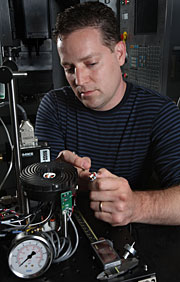- Number 342 |
- July 25, 2011
“Cooler” technology offers fundamental breakthrough in heat transfer

Sandia’s Jeff Koplow makes an
adjustment to an earlier
prototype of his Air Bearing
Heat Exchanger invention. The
technology, as known as the
“Sandia Coole,” will significantly
reduce the energy needed to
cool the processor chips in data
centers and large-scale
computing
environments.
(Photo by Dino Vournas)
DOE’s Sandia National Laboratories has developed a new technology with the potential to dramatically alter the air-cooling landscape in computing and microelectronics, and lab officials are now seeking licensees in the electronics chip cooling field to license and commercialize the device.
The “Sandia Cooler,” also known as the “Air Bearing Heat Exchanger,” is a novel, proprietary air-cooling invention developed by Sandia researcher Jeff Koplow, who was recently selected by the National Academy of Engineering (NAE) to take part in the NAE’s 17th annual U.S. Frontiers of Engineering symposium.
Koplow said the Sandia Cooler technology, which is patent-pending, will significantly reduce the energy needed to cool the processor chips in data centers and large-scale computing environments. The yearly electricity bill paid by the information technology sector in the U.S. is currently on the order of seven billion dollars and continues to grow.
Dramatic improvements in cooling, other benefits
In a conventional CPU cooler, the heat transfer bottleneck is the boundary layer of “dead air” that clings to the cooling fins. With the Sandia Cooler, heat is efficiently transferred across a narrow air gap from a stationary base to a rotating structure. The normally stagnant boundary layer of air enveloping the cooling fins is subjected to a powerful centrifugal pumping effect, causing the boundary layer thickness to be reduced to ten times thinner than normal. This reduction enables a dramatic improvement in cooling performance within a much smaller package.
Additionally, the high speed rotation of the heat exchanger fins minimizes the problem of heat exchanger fouling. The way the redesigned cooling fins slice through the air greatly improves aerodynamic efficiency, which translates to extremely quiet operation. The Sandia Cooler’s benefits have been verified by lab researchers on a proof-of-concept prototype approximately sized to cool computer CPUs. The technology, Koplow said, also shows great potential for personal computer applications.
Broader energy sector applications
The Sandia Cooler also offers benefits in other applications where thermal management and energy efficiency are important, particularly heating, ventilation and air-conditioning (HVAC). Koplow said that if Air Bearing Heat Exchanger technology proves amenable to size scaling, it has the potential to decrease overall electrical power consumption in the U.S. by more than seven percent.
A technical white paper on the Sandia Cooler technology can be found here.
Sandia’s work on the cooler technology was funded initially through internal investments. Follow-on funding is also being provided by the Department of Energy’s Office of Energy Efficiency and Renewable Energy (EERE).
Submitted by DOE's Sandia National Laboratories
